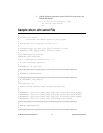
Using PCI Serial with Linux 10 www.natinst.com
Configure PCI-485
If you are using a PCI-485 interface, you can select the transceiver
mode for each device and select the lower baud rates listed in
termios_program.c provided in your PCI-SERIAL directory.
Select Transceiver Mode
Use the rs485 program (from the PCI-SERIAL directory) to select the
transceiver mode.
rs485 sets the transceiver mode for only one serial port.
To set the transceiver mode for other serial ports, rerun
rs485 with a
different serial port number specified in the command line. For more
information on the transceiver control modes, refer to your serial getting
started manual. If you do not know which transceiver mode to use, choose
Four-Wire Mode.
Enter the following to use
rs485:
linux PCI-SERIAL# ./rs485 <
port number
> <
mode
>
rs485 Example
Enter the following to select Four-Wire Mode for /dev/ttyS5:
linux PCI-SERIAL# ./rs485 5 0
Lower Baud Rate Selection
To use a baud rate lower than 200, use setserial and the clockspeed
program (from the
PCI-SERIAL directory) to lower the baud base of a
single serial port from 460800 to 115200. After changing the baud base
to 115200, the max baud rate you can achieve is 115200 baud (until you
change the baud base back to 460800).
After you change the
baud_base of the serial port using setserial and
run the
clockspeed program, you can use the lower baud rate flags in
your programs. The
clockspeed program changes the baud base of only
Table 3.
Transceiver Mode Values
Transceiver Mode Mode
Four-Wire Mode 0
Two-Wire Mode: DTR with echo 1
Two-Wire Mode: DTR controlled 2
Two-Wire Mode: TXRDY auto
control
3


















